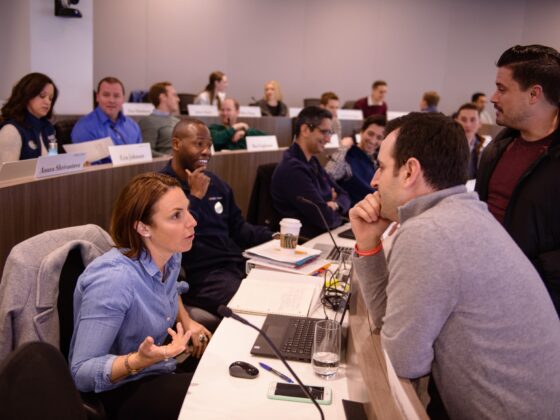Over the past few weeks, Darden has launched its application for the 2020 cycle, posted new application deadlines and offered insights about our short answer questions. To help you navigate the Darden admissions process, this post provides a step-by-step guide.
You can also check out our ongoing Application Tips series or join Executive Director of Admissions Dawna Clarke for an Application Launch webinar on 1 July at 12:30 p.m. EDT for more insights about applying to Darden. Dawna’s session will be a great orientation for any applicant seeking to learn more about the application process, and she will share insights about this year’s application as well as top tips for Darden applicants.
Below, find our step-by-step guide to application process below:
- Select Your Deadline
At UVA Darden, we offer four application deadlines:
Early Action: 3 September
Round 1: 4 October
Round 2: 6 January
Round 3: 6 April
Which deadline is right for you? Our general advice is to apply as soon as you feel like you can put together a strong application. With each passing deadline, fewer seats in our class will be available, and we will have less scholarship money to award. Most applicants will apply in Early Action, Round 1 and Round 2. That said, we always meet great candidates in our final round, Round 3. We have four application deadlines to provide you maximum options.
The Early Action round is unique among our deadlines in that we offer a number of open interview slots in this round. For all other rounds, interviews are by invitation only. While it is not binding, our Early Action round is generally recommended for candidates who know Darden is at the top of their list.
- Review our application
Once you have identified your target deadline, we encourage you to review our application. During this first pass, don’t worry about completing anything. Just read. What is required? What information will you need? How much time will it likely take you to complete each of the sections?
Taking 10–15 minutes to review our application as you embark upon this process will help you better plan and strategize.
- Acquire your transcripts
Unofficial transcripts are fine for the purposes of our application process, and we require transcripts for all degree-related coursework. An unofficial transcript is a transcript issued directly to you. It could be in the form of a PDF download or a document you scan and upload to your application. An official transcript is a transcript issued directly from the institution in question to our office.
If you completed your education at a non-English-speaking institution, you will need to make arrangements to have your academic records translated and sent to our office with the official transcript. All translations must be complete and literal versions of the original records.
If you matriculate at Darden, we will require you to submit official transcripts from all degree-granting institutions prior to the start of school. But for now, unofficial copies are just fine.
- Take the GMAT or GRE
In the full-time MBA application process, Darden accepts the GMAT and the GRE, and we view these tests as equivalent. We encourage candidates to choose the test that best aligns with their strengths and application plans. Self-reported scores are fine for the purposes of our application process, but you should also arrange for GMAC, ETS or Pearson Vue to send your official score report to the Darden Admissions office.
We also accept the MCAT or LSAT. If you have already taken one of these tests, we encourage you to reach out to our office to discuss if submitting your MCAT or LSAT score is the best course of action.
Remember: Standardized tests are just one piece of information in a much broader, holistic evaluation.
Additional resources:
- Video: Standardized Test Insights with Dawna Clarke
- Video: Standardized Test Tips with Dawna Clarke
- Blog Post: How We Think About Standardized Tests
- Blog Post: Applicant FAQs – Quantitative Experience
- Blog Post: Applicant FAQs – Strengthening Your Quantitative Profile
- Sharpen Your Resume
For most full-time MBA applicants, a one- or two-page resume is sufficient. If you’ve reviewed our application (see Step 2), you know there is an Employment History section, and, in this section, you will provide basic details about your various roles and responsibilities. We encourage you to keep this in mind when crafting your resume. Remember, we will be evaluating your application holistically, so try to think about your application with this lens as you assemble your materials.
Consider using your resume to highlight your leadership and impact. What have you accomplished in your roles? And whenever possible, try to quantify your results.
In addition, a resume is also an opportunity to display your personality and offer insights about your passions and interests. Hobbies, favorite activities, books you’ve read recently, podcasts you’re currently listening to, countries you’ve visited. It’s all fair game. Including a few of these personal details can help us get a more complete picture of you.
Additional resources:
- Video: Resume Advice: Leadership with Dawna Clarke
- Video: Resume Advice: Global Experience with Dawna Clarke
- Video: Resume Advice: Interests and Hobbies with Dawna Clarke
- Blog Post: Resume Guidance
- Identify your recommenders
We require two recommendations as part of our application process. Who makes a good recommender? It depends, but we typically suggest someone who knows you well and has supervised you in a professional setting. Identify people who will be strong advocates for you in the process and will help us learn more about your accomplishments and leadership potential. Of course, this is general advice, and we defer to you when it comes to actual recommender choice.
When choosing your recommenders (and setting your recommenders’ expectations), be sure to keep in mind what they will be asked to do. Our recommendation process is completely electronic, and your recommenders will fill out two pieces of information — a ratings grid in which they will evaluate you across a set of competencies and a series of short answer questions. The short answer questions are:
- Please provide a brief description of your interaction with the applicant and, if applicable, the applicant’s role in your organization.
- How does the performance of the applicant compare to that of other well-qualified individuals in similar roles?
- Describe the most important piece of constructive feedback you have given the applicant. Please detail the circumstances and the applicant’s response.
Recommendations are typically the slowest part of the application process, so identify your recommenders well in advance of your target deadline. Make sure they understand why you’re pursuing an MBA and why you’re interested in Darden. We also suggest sharing a copy of your resume with them so they have some perspective on the full arc of your career. And last but not least: Stay in touch. We find that most recommenders are deadline-oriented, so make sure they know your application timing.
Additional resources:
- Respond to Our Short Answer Questions
For the 2019–20 application cycle, we will again feature multiple short answer questions. Why multiple questions? To allow you a broader platform to showcase your background and personality. These questions are a great opportunity for you to help the Darden Admissions Committee understand who you are and who you will be at Darden.
Remember: We are not reading your responses with a prescribed or “right” answer in mind. We want to get to know you, not us. These questions are our opportunity to begin to get a sense of your voice, your perspective, your experiences and your writing ability. In fact, how you choose to answer a particular question is often as insightful as what you choose to write about. The best essay responses are those that are responsive to the question but also authentic and genuine. Whenever possible, show don’t tell.
Additional resources:
- Video: Essay Advice with Dawna Clarke
- Blog Post: All About Our 2019-20 Short Answer Questions
- Blog Post: Essay Tips
- Blog Post: Additional Essay Insights
- Complete the Application
Now that you have pulled together your supporting materials, you can focus on filling out your application. This includes everything from providing basic information about you (address, date of birth, contact details, etc.); to detailing your educational and employment history; to uploading your resume, transcripts and test scores; to adding your short answer responses and more.
Once you’ve entered all of this information, take a moment to think about your application holistically. Are there any gaps or ambiguities in the information provided? Consider using the Additional Comments section of your application to provide additional context, if necessary. The Additional Comments section is not an additional essay, just a place to connect the dots.
Our advice is to be brief, make your point and provide action items if appropriate. Be mindful that we are reading many, many applications, so anything you choose to share should be valuable to both you and potentially our Admissions Committee.
When you start your application, you will make two choices that are very important. From the first dropdown menu, you will select your application type: MBA (i.e., Full-Time MBA) or Executive (i.e., Executive MBA). Once you’ve made this choice, from the second dropdown menu, you will select your target deadline (2020 MBA Early Action, 2020 MBA Round 1, etc.). Please make sure you select the application type that corresponds to your program interest.
Additional resources:
- Pay the Application Fee
A nonrefundable application fee of $250 is a required to process your application. However, we do offer fee waivers in select circumstances. For more details, please see the Application Requirements page.





